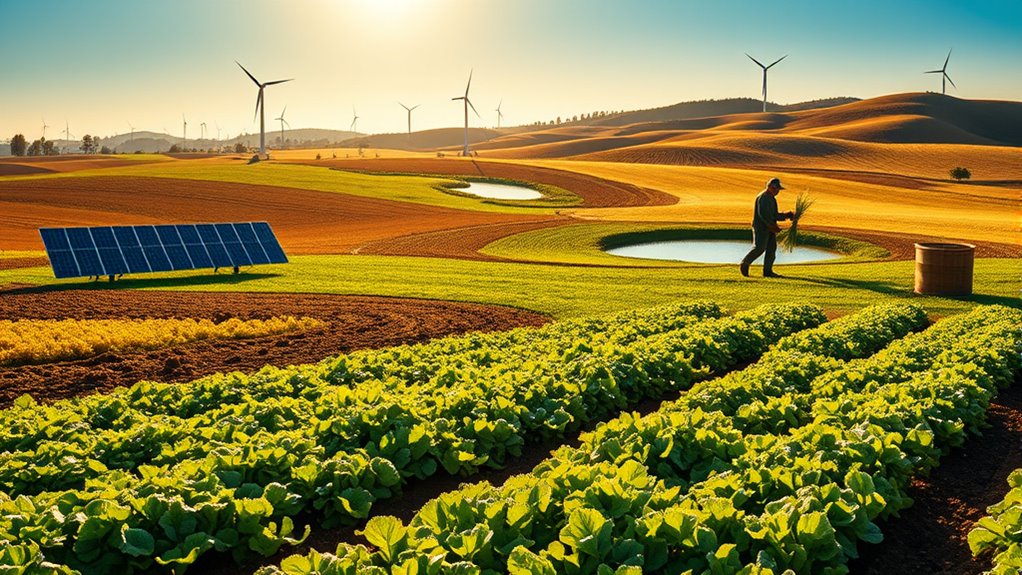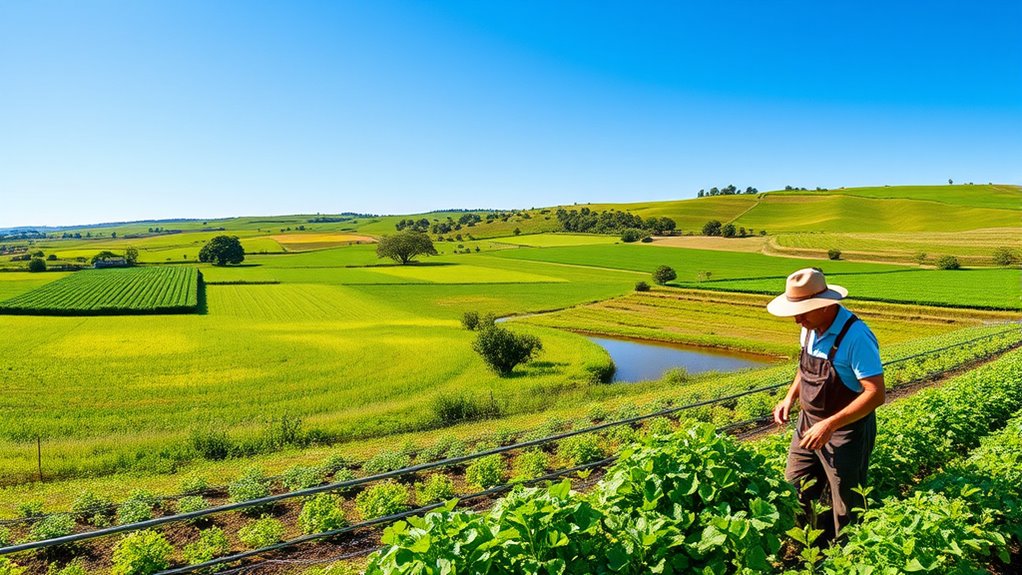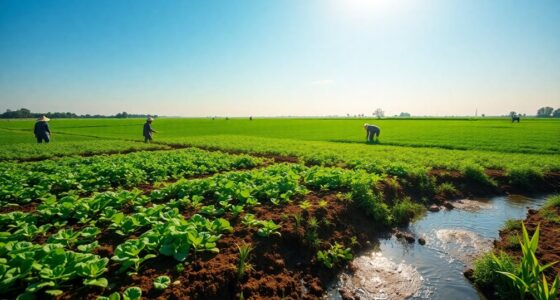Regenerative agriculture is transforming farming by boosting profitability, improving soil health, and reducing environmental impacts. You can save costs on inputs, access premium markets, and build resilience against climate change. Practices like cover cropping, no-till, and crop rotation enhance soil fertility, biodiversity, and water efficiency. Supportive policies and innovative tech make scaling easier, but challenges remain. Keep exploring—this sustainable approach is shaping the future of farming more than ever.
Key Takeaways
- Regenerative agriculture boosts farm profitability by reducing input costs and enabling premium product pricing.
- It enhances soil health and biodiversity, improving resilience against climate change and extreme weather.
- Adoption of practices like cover cropping and no-till farming increases resource efficiency and water conservation.
- Traceability and certification open global markets, appealing to consumers seeking ethically produced goods.
- Policy support, education, and scalable technologies are critical for widespread adoption and long-term sustainability.
Enhancing Farm Profitability and Economic Resilience

Adopting regenerative farming practices can substantially boost your farm’s profitability and economic resilience over time. By reducing input costs like synthetic fertilizers and pesticides, you save money while improving soil health. Although grain yields may be slightly lower—about 29%—the increased profits from premium prices and lower expenses more than compensate. For example, U.S. wheat farmers practicing regenerative methods can see profit gains up to 120%. Soil management techniques such as conservation tillage and cover cropping increase net income by roughly $50 per acre for crops like corn and soybeans. Eliminating chemical inputs and diversifying crops further enhance profitability, often resulting in up to 78% higher returns compared to conventional systems. These practices make your farm more financially stable and better equipped to withstand market fluctuations.
Climate Benefits and Carbon Reduction Strategies

By adopting regenerative practices, you can boost your farm’s carbon sequestration, turning your land into a powerful carbon sink. These methods also enhance climate resilience by helping your system withstand extreme weather and climate shocks. Embracing these strategies not only benefits the environment but also strengthens your farm’s long-term stability. Incorporating soil health improvements into your regimen can further optimize carbon storage and promote sustainable growth. Additionally, understanding the importance of contrast ratio in visual displays highlights how attention to detail can improve communication and presentation of your farming data. Utilizing solar-powered monitoring equipment can provide real-time insights into your soil and crop health, aiding in more precise and sustainable management. Research supports that hydrocolloid technology plays a significant role in promoting soil and plant health, making it an essential component of regenerative agriculture.
Carbon Sequestration Potential
Have you ever wondered how regenerative agriculture can combat climate change? It’s because these practices boost the soil’s ability to sequester carbon, turning farmland into a natural carbon sink. By planting cover crops, reducing tillage, and practicing crop rotation, you increase soil organic matter, trapping atmospheric CO2 underground. Studies suggest that if regenerative farming covered just 40% of global cropland, it could reduce emissions by around 600 million tons annually. This process not only curtails greenhouse gases but also enhances soil fertility and water retention. You help mitigate climate change while improving farm resilience. Implementing these strategies creates a win-win: healthier soils, increased carbon storage, and a more sustainable future for agriculture. Innovative farming techniques are continuously being developed to further maximize these environmental benefits.
Climate Resilience Enhancements
Implementing regenerative agriculture practices directly enhances climate resilience by strengthening your farm’s ability to withstand extreme weather events and climate shocks. By improving soil health through cover cropping, no-till, and diverse crop rotations, you boost water retention and reduce erosion, helping your land better absorb droughts and heavy rains. These practices also increase organic matter, making soils more resilient to temperature fluctuations. Carbon sequestration methods not only reduce greenhouse gases but also create a buffer against climate variability. Enhanced nutrient cycling and water efficiency lower your farm’s reliance on external inputs, decreasing vulnerability to supply chain disruptions. Additionally, adopting goal setting techniques from personal development can help farmers plan and implement sustainable practices more effectively. Incorporating vertical storage solutions can optimize on-farm space for equipment and supplies, making operations more adaptable. Understanding gold IRA options can offer additional financial stability and diversification for farm owners planning for long-term sustainability. Building climate resilience into your farm’s strategy ensures that your operations remain productive and adaptable in the face of changing environmental conditions. Emphasizing soil health through regenerative practices creates a stronger foundation for weather variability and climate impacts. Overall, regenerative strategies build a robust system that adapts to climate challenges, ensuring long-term productivity and stability in an unpredictable climate future.
Restoring Soil Vitality and Fertility

Restoring soil vibrancy and fertility is essential for sustainable farming, as healthy soils form the foundation for productive and resilient cropping systems. By adopting regenerative practices, you can rebuild organic matter, which boosts nutrient availability and supports a thriving soil microbiome. Cover cropping protects soil from erosion, increases biomass, and enhances nutrient cycling. No-till farming preserves soil structure, improves water infiltration, and reduces disturbance. Crop rotation diversifies nutrients and breaks pest cycles, promoting long-term soil health. Composting adds organic matter, improving moisture retention and nutrient content. These methods not only restore soil vitality but also reduce dependency on chemical inputs. As your soil health improves, you’ll see increased resilience to climate stresses, better crop yields, and a more sustainable, productive farm ecosystem.
Promoting Biodiversity and Ecosystem Health

Promoting biodiversity and ecosystem health is essential for creating resilient farms that can withstand environmental stresses. When you adopt regenerative practices, you support a thriving variety of plants, insects, and animals that work together to maintain balance. Imagine fields buzzing with native pollinators, beneficial insects controlling pests naturally, and diverse plant species covering the landscape. Utilizing effective security features helps protect these ecosystems from threats that could disrupt their delicate balance. Incorporating unique and wicked planters into farm landscapes can also support biodiversity by providing habitats for beneficial insects and small wildlife.
Supporting biodiversity creates resilient farms with healthy ecosystems and natural pest control.
Here are three ways you can enhance biodiversity:
- Plant diverse crop rotations that attract different beneficial species.
- Maintain hedgerows and natural habitats around fields to serve as wildlife corridors.
- Reduce chemical inputs to protect insects, birds, and soil organisms.
Improving Resource Efficiency and Water Conservation

By adopting regenerative farming practices, you can substantially enhance resource efficiency and conserve water on your land. Techniques like cover cropping, no-till farming, and crop rotation improve soil structure, increasing water retention and reducing evaporation. These methods lower your reliance on synthetic fertilizers by boosting nutrient use efficiency, meaning you use inputs more effectively. Managed grazing mimics natural patterns, promoting healthier soil that absorbs and retains more moisture. Conservation tillage minimizes soil disturbance, decreasing runoff and erosion while conserving moisture. As a result, your farm becomes more resilient to droughts and water shortages. Understanding self watering plant pots and similar innovative practices can further optimize water management in sustainable agriculture. Incorporating watering systems designed for efficient water use can significantly enhance conservation efforts. Additionally, exploring low light office plants can inspire new ways to incorporate greenery that requires less water, enhancing sustainability. Implementing rainwater harvesting techniques can also provide an additional water source, further reducing dependence on external supplies. Moreover, integrating soil moisture sensors can help monitor water levels more precisely, allowing for smarter irrigation scheduling. Overall, these practices help you optimize water resources, reduce waste, and strengthen the long-term sustainability of your land.
Transforming Supply Chains and Market Opportunities

How can regenerative agriculture reshape supply chains and open new market opportunities? By emphasizing transparency, sustainability, and quality, you can tap into new consumer demands and create more resilient markets. Imagine:
- Traceable supply chains that showcase farm practices, building trust and allowing premium pricing. This transparency can also appeal to consumer preferences for ethically produced goods. Incorporating record-keeping systems enhances traceability and accountability throughout the supply chain. Additionally, adopting personality insights can facilitate better communication and collaboration among supply chain stakeholders. Integrating AI security ensures that sensitive data related to farm practices and certifications remains protected from cyber threats, maintaining integrity in the digital traceability systems.
- Local and regional markets thriving with fresh, sustainably grown produce that appeals to eco-conscious buyers.
- Certification programs, like Organic or Regenerative Organic Certified, opening doors to global markets and commanding higher prices.
- Implementing regenerative practices can further enhance soil health and boost yields, strengthening your market position. As these practices become more widespread, they can also reduce input costs over time, increasing profitability.
These shifts encourage collaboration across farmers, processors, and retailers, reducing dependency on chemical inputs and long-distance transportation. As a result, you can access niche markets, increase profitability, and strengthen community connections—all while promoting environmental health. This transformation fosters a more sustainable, profitable farming landscape.
Adoption Drivers and Policy Support for Regenerative Practices

Adoption of regenerative practices is increasingly driven by a combination of economic incentives, policy initiatives, and growing awareness of environmental benefits. Governments offer subsidies and grants that reduce upfront costs, making it easier for you to implement these methods. Policies encouraging sustainable practices, like carbon credits and conservation programs, further support your efforts. Additionally, consumer demand for eco-friendly products motivates farmers to adopt regeneration for market access and higher premiums. Here’s how these drivers play out:
| Driver | Impact |
|---|---|
| Economic incentives | Lowered costs, increased profitability |
| Policy initiatives | Grants, subsidies, regulatory support |
| Consumer awareness | Market premiums, brand loyalty |
Furthermore, the integration of regenerative techniques into existing farming systems can enhance soil health and productivity over time. These factors combine to create a supportive environment, making regenerative agriculture more accessible and attractive for your farm’s future. Recognizing visionary insights into sustainable development can also inspire innovative approaches within regenerative practices.
A focus on long-term sustainability supports the resilience of your farm and encourages broader adoption of eco-friendly methods.
Innovations and Technologies Supporting Regeneration

Innovations and technologies are transforming regenerative agriculture by making sustainable practices more efficient and accessible. You can now leverage tools that optimize soil health, crop yields, and resource use. For example:
Innovative tools now enhance sustainable farming by improving efficiency and accessibility in regenerative practices.
- Precision agriculture GPS systems guide you to apply inputs only where needed, reducing waste and disturbance.
- Soil sensors provide real-time data on moisture, nutrients, and microbial activity, helping you make informed decisions.
- Drones and remote sensing monitor crop health and soil cover, enabling early detection of issues and targeted interventions.
These advancements empower you to implement regenerative practices with greater accuracy and confidence. They simplify complex processes like cover cropping or no-till farming, making widespread adoption more feasible and impactful. Technology is truly revolutionizing sustainable farming methods.
Challenges and Risks in Transitioning to Regenerative Farming

Switching to regenerative farming can be costly upfront, making it a tough investment for many farmers. You might also face knowledge gaps and limited training, which can hinder your progression. Additionally, market and policy uncertainties create risks that can affect your long-term success and profitability.
Transition Cost Barriers
Switching to regenerative farming involves significant upfront costs and risks that can deter farmers from making the shift. You might face initial investments in new equipment, cover crops, and soil amendments. Additionally, the changeover period can lead to temporary yield reductions, impacting your income. Here’s what you could encounter:
- High initial expenses that require capital and financing, straining your cash flow.
- Uncertainty in early returns, making it hard to predict profitability during the transition.
- Learning curve and adaptation, as new practices demand time, training, and patience to see benefits.
These barriers can feel overwhelming, especially without immediate financial gains. Overcoming them requires planning, support, and sometimes external funding to navigate the risks successfully.
Knowledge and Training Gaps
One of the main hurdles in adopting regenerative farming is the lack of widespread knowledge and training. Many farmers aren’t familiar with the principles of soil health, crop rotation, or cover cropping, which are crucial for success. Without proper education, you may struggle to implement practices effectively or risk unintended consequences like poor yields or soil degradation. Limited access to technical guidance and training programs further complicates the changeover. Additionally, traditional agricultural education often emphasizes chemical inputs and conventional methods, leaving a knowledge gap for regenerative techniques. Overcoming this challenge requires targeted training, accessible resources, and peer learning networks. Building your understanding of regenerative practices is essential to guarantee you can navigate risks, optimize benefits, and sustain long-term farm productivity.
Market and Policy Uncertainties
Are market and policy uncertainties holding you back from adopting regenerative farming? These challenges can make the shift seem risky. Imagine:
- Navigating unpredictable crop prices that fluctuate with changing consumer preferences.
- Facing inconsistent government support, subsidies, or certification standards that complicate market access.
- Dealing with evolving regulations that may delay or restrict regenerative practices.
These factors create ambiguity, making it hard to plan long-term investments. You might worry about whether premium prices will sustain or if policies will favor conventional farming. Without clear incentives or stable markets, you risk uncertain returns. Overcoming these hurdles requires advocacy and policy development that recognize the environmental and economic benefits of regenerative agriculture, ensuring you can confidently transition without fear of economic setbacks.
The Future Outlook: Scaling and Sustaining Regenerative Agriculture

Scaling and sustaining regenerative agriculture requires a strategic approach that builds on proven benefits while addressing current barriers. To do this, focus on expanding access through education, technical support, and financial incentives that encourage farmers to adopt these practices. Policymakers and industry stakeholders must collaborate to create supportive frameworks, like subsidies or certification programs, that reward sustainable methods. You should also prioritize developing scalable technologies, such as no-till equipment and cover crop seeds, to lower entry costs. Long-term success depends on demonstrating economic viability, so collecting data on profitability and environmental impacts will be essential. Building community networks and knowledge-sharing platforms can foster peer learning and innovation, ensuring regenerative farming becomes a resilient, widespread system that benefits both farmers and ecosystems.
Frequently Asked Questions
How Do Regenerative Practices Impact Crop Yields During Transition Periods?
During the shift to regenerative practices, your crop yields may dip initially due to changes like reduced chemical inputs and soil disturbance. However, as soil health improves over time, you’ll notice increased fertility, water retention, and pest resilience. These benefits lead to stabilized or even higher yields in the long run. Patience is key, and embracing the process helps guarantee sustainable growth and profitability as your land adapts.
What Are the Cost Implications of Adopting Regenerative Farming Methods?
Adopting regenerative farming can initially feel like planting a forest—costly upfront but rewarding long-term. You might spend more on cover crops or no-till equipment at first, but studies show that within six years, profits can increase by up to 60%, thanks to lower input costs and premium prices. Plus, you save money on fertilizers and pesticides, making the investment worthwhile as soil health improves and yields stabilize.
How Can Farmers Effectively Measure Soil Health Improvements?
You can effectively measure soil health improvements by monitoring key indicators like organic matter levels, soil structure, microbial activity, and nutrient cycling. Use tools such as soil testing labs, standardized soil health assessment protocols, and remote sensing technologies. Keep track of changes over time, compare results with baseline data, and incorporate soil health metrics like infiltration rates and erosion risk. Regular monitoring helps you gauge progress and adjust practices accordingly.
Are There Certifications That Verify Regenerative Farming Claims?
Yes, there are certifications that verify regenerative farming claims. You can pursue programs like USDA Organic, Regenerative Organic Certified (ROC), and Rainforest Alliance, which set standards for sustainable and regenerative practices. These certifications require you to meet specific criteria around soil health, biodiversity, and resource use. Getting certified can help you communicate your practices to consumers, access premium markets, and verify that your farm genuinely follows regenerative principles.
What Policies Support the Economic Viability of Regenerative Agriculture?
You’ll find policies like government subsidies, grants, and tax incentives vital for supporting regenerative agriculture’s economic viability. For example, U.S. wheat farmers can see profitability gains of up to 120% with these practices. These policies help offset initial costs, encourage adoption, and promote ecosystem service payments. They also facilitate certification programs, enabling farmers to access premium markets, making regenerative practices more financially sustainable and attractive over the long term.
Conclusion
By embracing regenerative agriculture, you can boost farm profits while helping combat climate change—did you know that regenerative practices can increase soil carbon storage by up to 20%? As you adopt these methods, you’ll enhance soil health, promote biodiversity, and conserve water. Though challenges exist, supporting policies and innovations are making the future of farming more sustainable. Together, you can play a crucial role in transforming agriculture for a healthier planet.





